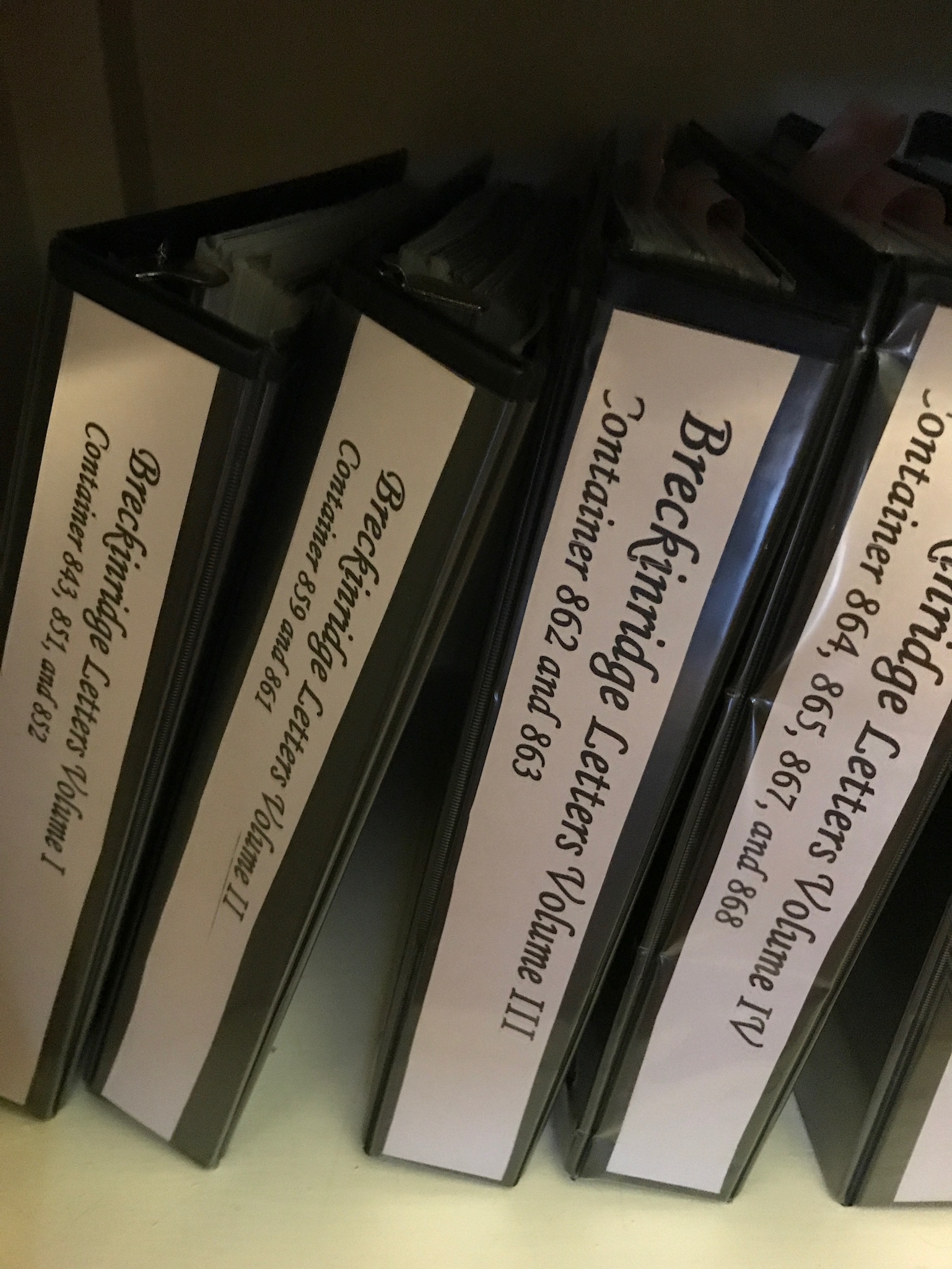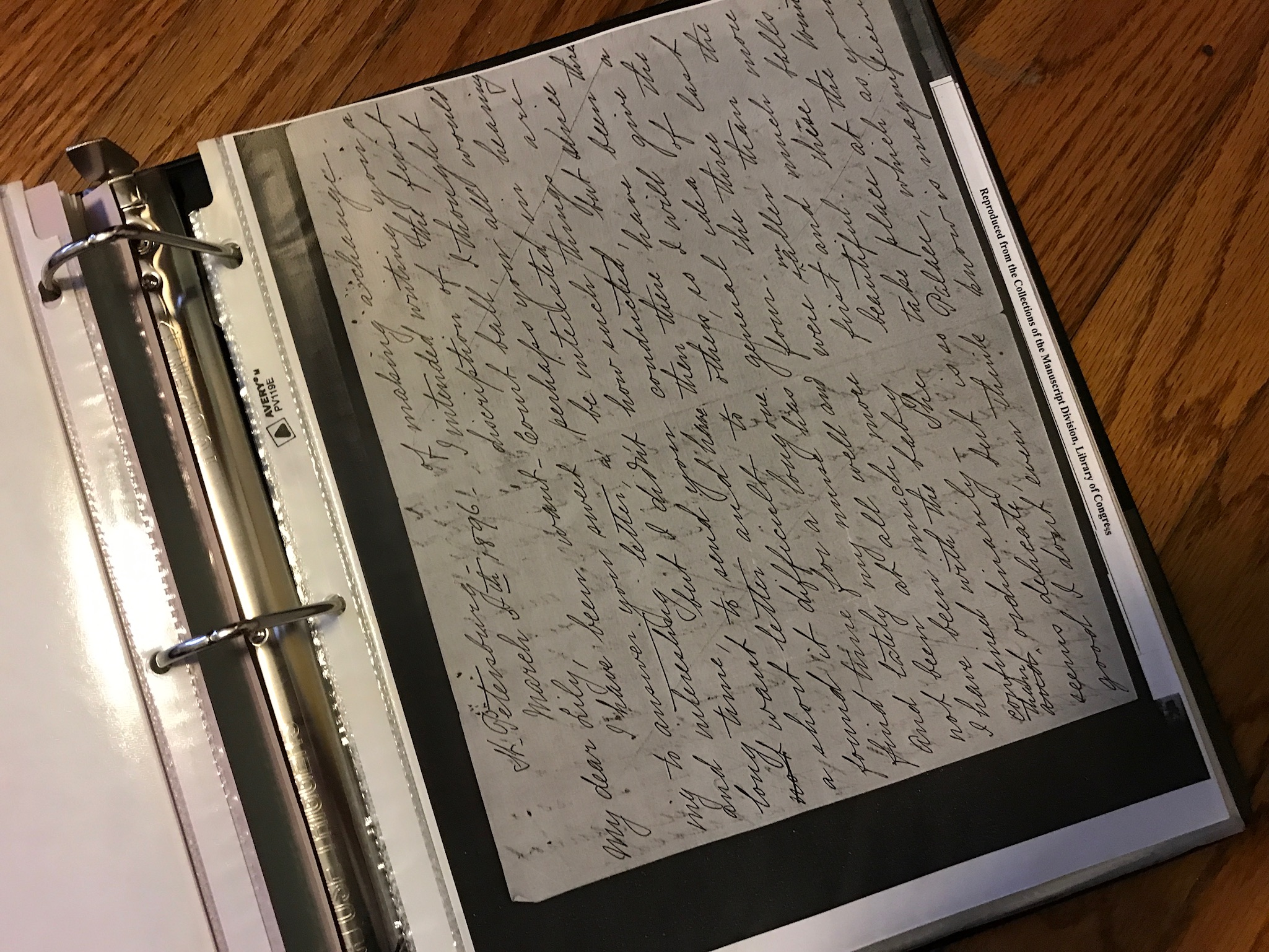
It may have started with a dress but it’s really all about the letters! And the letters are truly incredible! And I promise I’m working up to actually posting the letters! All in good time!
Katherine Carson Breckinridge wrote thousands of letters to friends and family during her lifetime. Fortunately for us, she saved them, and somehow they got included in the Breckinridge Family Papers collection at the Library of Congress – Manuscript Reading Room. The Breckinridge Family Papers is a huge collection with 206,000 items in 875 containers plus 37 microfilm reels. The total is 265 linear feet. If you want to take a look at the outline of the collection, here’s the finding aid. KCB’s Containers are 861 through 864 totaling 23 folders.
KCB’s stuff is mainly in two sections of the collection: Other Family Papers 1779-1965 and Addition I, 1816-1980. Other items related to KCB are in Clifton’s stuff as well as folders marked with her maternal aunt, Susanna Preston Lees’ name, her daughter Mary Carson Breckinridge (of Frontier Nursing Service fame), and her other children. And even though KCB married into the Breckinridge family, some of her mother’s, father’s, and brothers’ papers are in the collection as well.
And it’s just not letters home from Russia but letters between KCB and Clifton during their courtship and early marriage. And early writing from her childhood. And her Daughters of the American Revolution membership application. I was looking for details about the wedding and coronation of Nicholas and Alexandra. And that’s there but there is so much more.
Between 2001 and 2011, I took 6 trips to do research on KCB’s papers. On my first trip, I was so naive about researching in a big archive. I had done research at the Arkansas History Commission and other local university archives. But the Library of Congress is the real deal! I arrived armed with my dad’s laptop and a lot of determination. I was going to start by looking at the Russia letters and getting an inventory. My plan was to transcribe as many letters as I could during that trip. But spending 8 hours in a quiet reading room reading (and deciphering) old letters written on thin paper is exhausting – physically and mentally. But it’s exhilarating as well. That first trip was a full week. And I got a lot done but also realized how much more there was to do.

My next trip was a game changer! Hello, copy machine!!!! During this research trip, I noticed that a lot of researchers were taking files, one at a time, over to the copy machines that lined one wall of the room. It took me about an hour to get up the courage to go up to the desk with my folder (Why do you always feel like a kid when you have to ask for permission to do something like that!) But what could it hurt, right? All they can say is no! So I walked up to the desk with a folder and asked. And they said YES!!!! I just needed to ask about each folder and keep everything in its original order. YES!!!!!

Problem! It’s $.15 per page to make a copy on their fancy digital copy machines!!! Only $.10 per page for the regular machine! But it had to be digital or nothing! And I had hundreds of letters, double-sided!!! Well, you only live once right?!?!?! So I did something I’d never done before. I marched across the street and made a CASH withdrawal from my credit card at the ATM! With cash in hand, I returned to LOC, purchased a copy card, and loaded it! Let the photocopying begin!
When it comes to research, I definitely use the scoop-and-run approach! Because my time is often limited in the archive, I want to get as much done so I can “process” what I found later. The key to this method (and I’m not always successful) is to make sure you process soon – like that night or that week. Because if you let time lapse you often think “Why did I think this was important???”
So photocopying was great for me! I could get a lot done and “process” it later! It is important to keep the letters together during the photocopying process. As I mentioned earlier, KCB’s letters are multi-pages, double-sided. In some cases, one letter could be 10 photocopied pages. And of course, she didn’t number her pages. I had to be EXTREMELY careful to keep one letter together and the pages in order! And for citation purposes, I need to know what container and folder each letter came from!

When I returned home from each trip, it was time to get everything organized for safekeeping. Enter binders and sheet protectors! Because the photocopies were precious to me (maybe as precious as the originals), I didn’t want to hole-punch them. Plus I didn’t want to risk losing anything important. So each letter got its own sheet protector. I know I could have done front to back and make them like a book but I didn’t want to risk getting anything out of order. Keeping everything in order was paramount. I think I even had nightmares that two letters would get mixed up and pages would intermingle with each other. Can you imagine?

All so amazing and fascinating. There is a book in here someday not just the subject matter but also your process and feelings etc.
LikeLike